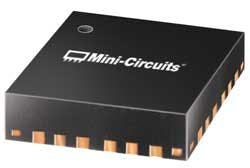Monolithic InGaP Mixer Converts 2.2 to 7.0 GHz
This file type includes high resolution graphics and schematics when applicable.
Mixers have long been the lifeblood of Mini-Circuits, dating back to the company’s humble beginnings. Even as the company has evolved to develop a wide range of active and passive components and test equipment, RF mixers have remained almost synonymous with the name “Mini-Circuits.” Traditionally, those mixers have been based on discrete device technology rather than on the use of integrated circuits (ICs). With the model MDB-73H+, however, the firm unveils its first monolithic-microwave-integrated-circuit (MMIC) mixer—and what a mixer it is.
Housed in a tiny 4-×-4-×-1 mm, 24-lead MCLP surface-mount-technology (SMT) package, the model MDB-73H+ double-balanced mixer handles RF and local oscillator (LO) frequencies from 2.2 to 7.0 GHz, with an intermediate-frequency (IF) range of DC to 1.6 GHz. It achieves low, flat conversion loss across that broad frequency range for outstanding performance in a wide range of applications, from communications to radar systems.
The model MDB-73H+ double-balanced mixer (see figure) makes use of indium-gallium-phosphide (InGaP)/gallium-arsenide (GaAs) semiconductor materials. Although InGaP/GaAs materials might be best known for their use in solar cells, their outstanding electron velocity characteristics makes them excellent candidates for high-frequency and high-power devices, including high-electron-mobility-transistor (HEMT) and heterojunction-bipolar-transistor (HBT) devices.
In fact, the model MDB-73H+ mixer employs an InGaP HBT structure with integrated LO and RF baluns to achieve its broad frequency range with almost negligible conversion loss. Combined with the mixer’s small size and convenient SMT packaging, the component can be used for frequency upconversion and downconversion in a wide range of commercial and defense-related applications—ranging from radar to satellite-communications (satcom) systems.
The model MDB-73H+ mixer is referred to as a “Level 15” mixer, rated for typical LO power of +15 dBm. When measured with an IF of 30 MHz, the conversion loss was typically 8.8 dB at 2.2 GHz; 8.2 dB at 4.0 GHz; 9.3 dB at 6.0 GHz; and 8.9 dB at 7.0 GHz. The typical LO-to-RF isolation is 38 dB at 2.2 GHz; 39 dB at 4 GHz; 35 dB at 6 GHz; and 34 dB at 7 GHz. The typical isolation between the LO and IF ports is 36 dB at 2.2 GHz; 46 dB at 4 GHz; 46 dB at 6 GHz; and 33 dB at 7 GHz. The typical isolation between the RF and IF ports is 8 dB at 2.2 GHz; 17 dB at 4 GHz; 13 dB at 6 GHz; and 12 dB at 7 GHz.
The double-balanced mixer typical reaches its 1-dB compression point with +10-dBm input (RF or IF) power. The mixer achieves typical input third-order-intercept (IP3) point of +18 dBm at 2.2 GHz; +24 dBm at 4.0 GHz; +23 dBm at 6.0 GHz; and +22 dBm at 7.0 GHz. It has a noise figure of 8.9 dB at 2.2 GHz and 9.0 dB when measured at 4 GHz. The thermal resistance, as measured from the junction to the ground lead, is typically +105°C/W.
The tiny InGaP/GaAs mixer is rated for maximum RF power of +21 dBm and maximum LO power of +21 dBm, with maximum IF current of 30 mA. The mixer has an operating temperature range of -40 to +85°C, making it a candidate for a variety of different commercial and military applications. The SMT package includes a tin-silver-nickel finish claimed to be capable of passing a tin-whisker test.
For a firm with a long history based on discrete RF mixer technology, this first high-frequency mixer based on MMIC technology is a good first step in the direction of IC mixers and its broadband bandwidth and level conversion loss offer a hint of what lies ahead. The MDB-73H+ is certainly a double-balanced mixer—one that can be made to fit easily within any application in its frequency range. P&A: $6.95 each (20 qty.); stock.
Mini-Circuits, P.O. Box 350166, Brooklyn, NY 11235-0003; (718) 934-4500, FAX: (718) 332-4661
This file type includes high resolution graphics and schematics when applicable.
About the Author
Jack Browne
Technical Contributor
Jack Browne, Technical Contributor, has worked in technical publishing for over 30 years. He managed the content and production of three technical journals while at the American Institute of Physics, including Medical Physics and the Journal of Vacuum Science & Technology. He has been a Publisher and Editor for Penton Media, started the firm’s Wireless Symposium & Exhibition trade show in 1993, and currently serves as Technical Contributor for that company's Microwaves & RF magazine. Browne, who holds a BS in Mathematics from City College of New York and BA degrees in English and Philosophy from Fordham University, is a member of the IEEE.


